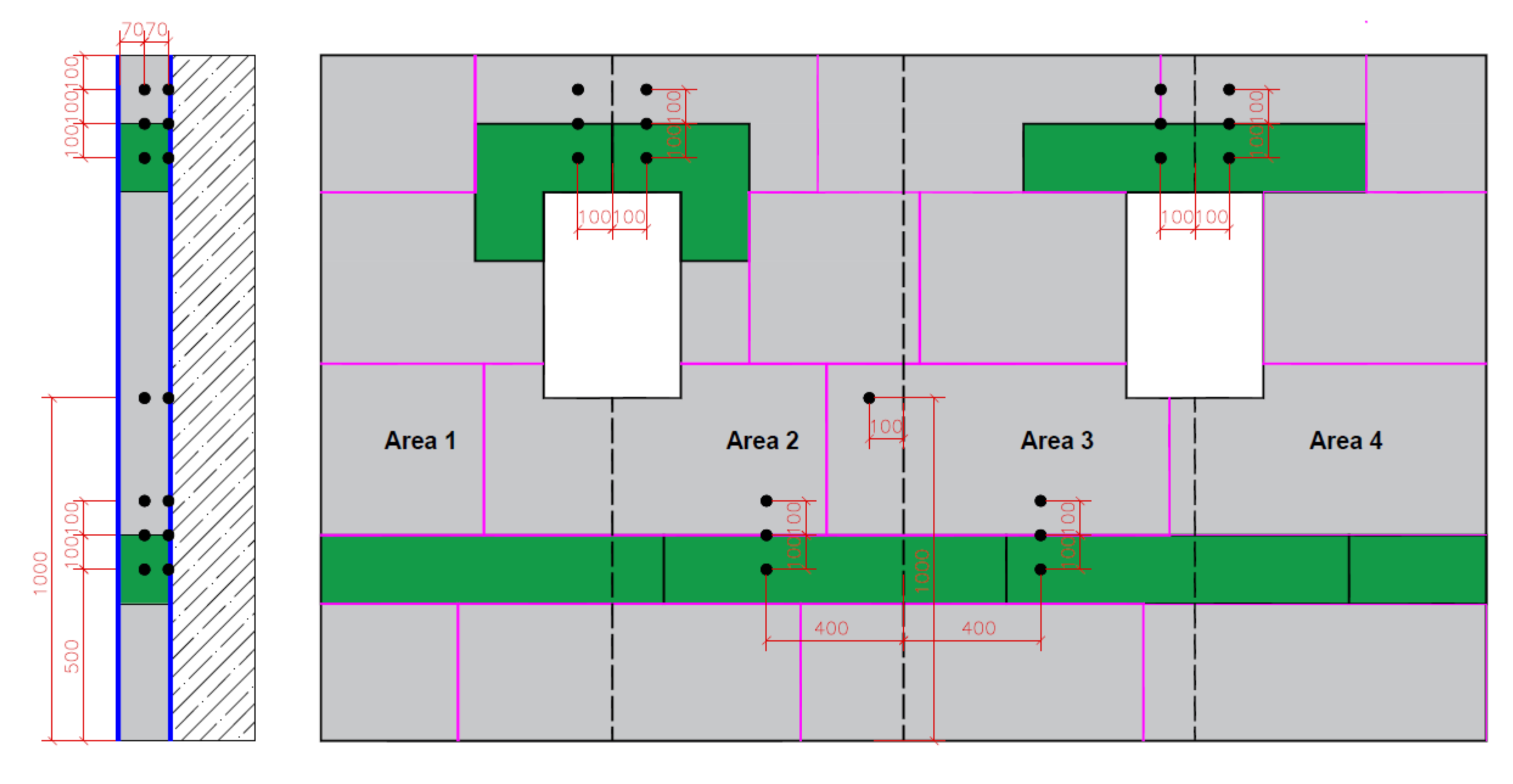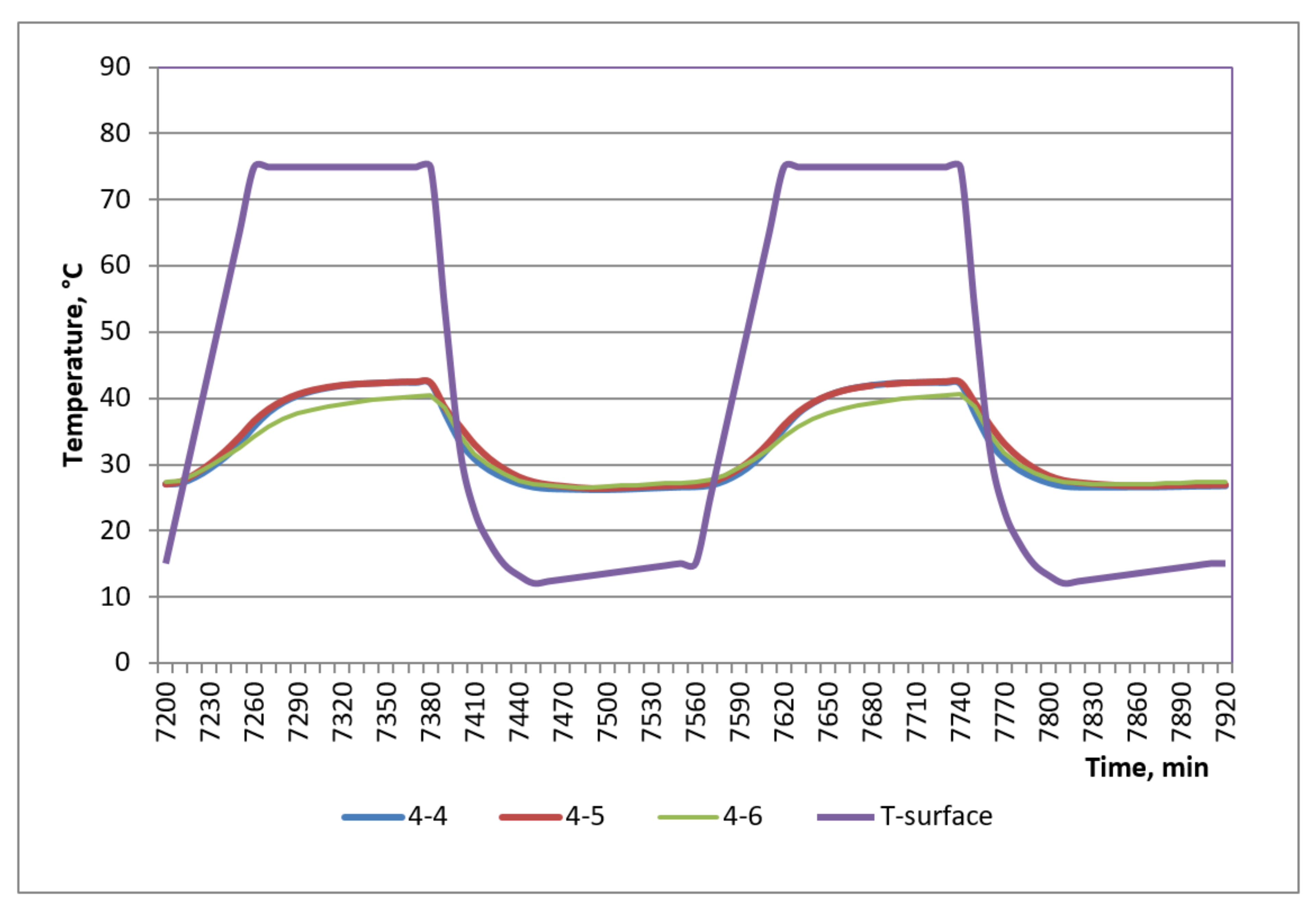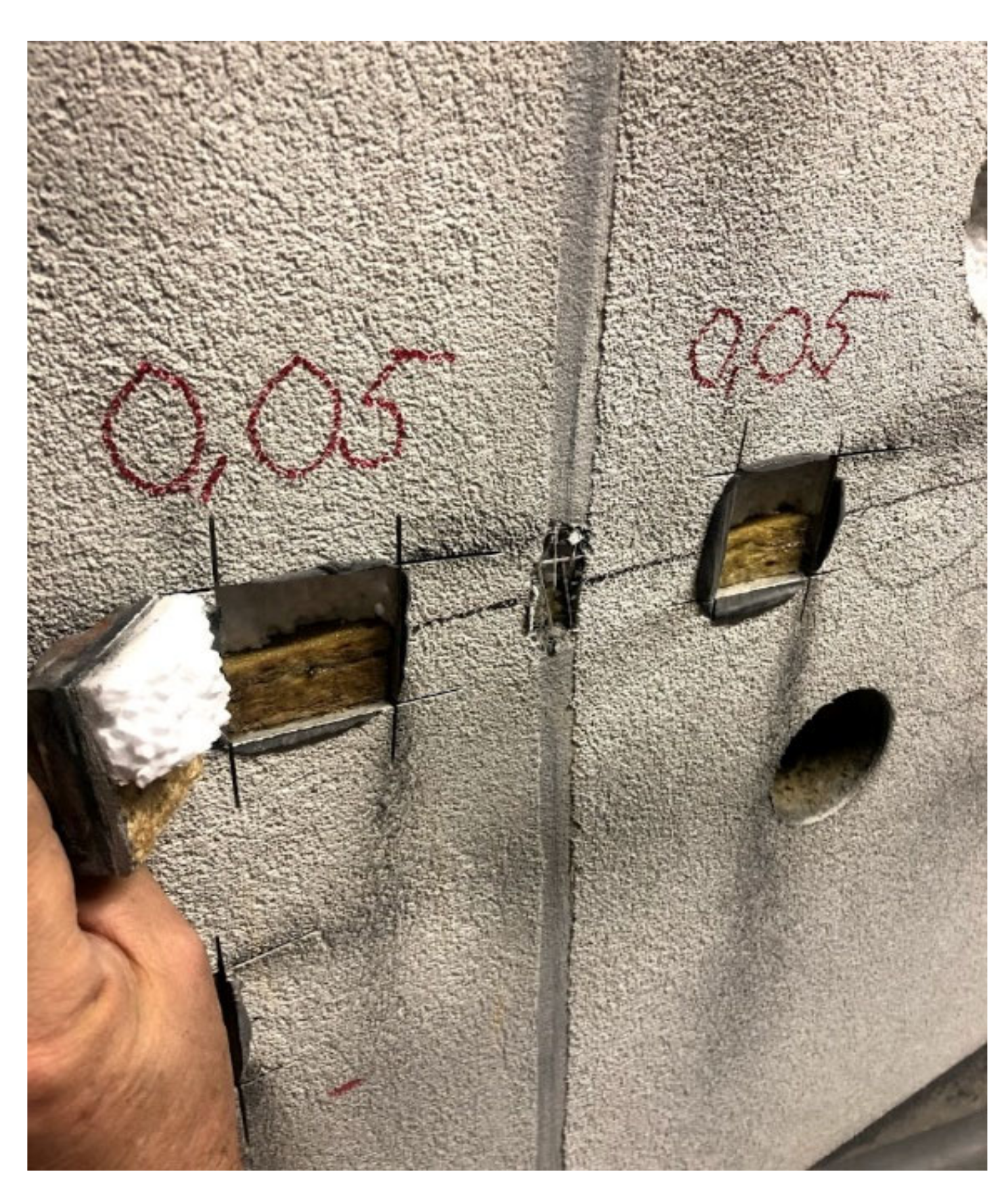Resistance of ETICS with Fire Barriers to Cyclic Hygrothermal Impact
Abstract
:1. Introduction
2. Methodology and Materials
- heating to 70 °C and maintaining this temperature at 70 ± 5 °C and relative humidity at the level of 10–30% for 2 h (3 h in total);
- sprinkling with water at a temperature of 15 ± 5 °C in the amount of 1 L/m2 for 1 h and leaving the rig for a period of 2 h.
- heating to 50 ± 5 °C and 30% RH for 7 h;
- freezing to −20 ± 5 °C for 14 h.
3. Results and Discussion
3.1. Moisture Transfer
3.2. Temperature Profile
3.3. Bond Strength
3.4. Impact Resistance
4. Conclusions
Author Contributions
Funding
Institutional Review Board Statement
Informed Consent Statement
Data Availability Statement
Conflicts of Interest
References
- Daniotti, B.; Paolini, R. Evolution of degradation and decay in performance of ETICS. In Proceedings of the 11th International Conference on Durability of Building Materials and Components, Istanbul, Turkey, 11–14 May 2008; p. 42. [Google Scholar]
- Gaciek, P.; Gaczek, M.; Garecki, M. Sposoby mocowania ociepleń do powierzchni ścian według technologii ETICS. Izolacje 2018, 23, 20–22. [Google Scholar]
- Liismaa, E.; Sepria, R.; Raadob, L.-M.; Lillc, I.; Wittd, E.D.Q.; Sulakatkoc, V.; Põldarua, M. Defect analysis of renovated facade walls with etics solutions in cold climate conditions. In Proceedings of the CESB16: Central Europe towards Sustainable Building, Prague, Czech Republic, 22–24 June 2016. [Google Scholar]
- Pečur, I.B.; Bjegović, D.; Boström, L.; Milovanović, B. ETICS Fire Performance Test. In Proceedings of the Fifth International Workshop on Performance, Protection & Strengthening of Structures Under Extreme Loading, East Lansing, MI, USA, 28–30 June 2015; Available online: https://www.researchgate.net/publication/280385277_ETICS_Fire_Performance_Test (accessed on 15 December 2018).
- Sulakatko, V.; Liisma, E.; Soekov, E. Increasing construction quality of external thermal insulation composite system (ETICS) by revealing on-site degradation factors. Procedia Environ. Sci. 2017, 38, 765–772. [Google Scholar] [CrossRef]
- Sulakatko, V.; Vogdt, F. Construction process technical impact factors on degradation of the external thermal insulation composite system. Sustainability 2018, 10, 3900. [Google Scholar] [CrossRef] [Green Version]
- Barreira, E.; de Freitas, V.P. Experimental study of the hygrothermal behaviour of external thermal insulation composite systems (ETICS). Build. Environ. 2013, 63, 31–39. [Google Scholar] [CrossRef]
- Liisma, E.; Lõhmus, G.; Raado, L. The effect of temperature and humidity on the permanence of external thermal insulation composite systems. Procedia Eng. 2015, 108, 340–348. [Google Scholar] [CrossRef] [Green Version]
- Šadauskienė, J.; Buska, A.; Ramanauskas, J.; Algimantas, V. Analysis of fire spread prevention measures in ETICS and their influence on durability. J. Sustain. Archit. Civil Eng. 2016, 17, 33–44. Available online: https://www.ceeol.com/search/article-detail?id=570694 (accessed on 20 December 2020).
- Steinbauer, V.; Kaufmann, J.; Zurbriggen, R.; Bühler, T.; Herwegh, M. Tracing hail stone impact on external thermal insulation composite systems (ETICS)—An evaluation of standard admission impact tests by means of high-speed-camera recordings. Int. J. Impact Eng. 2017, 109, 354–365. [Google Scholar] [CrossRef] [Green Version]
- Barreira, E.; de Freitas, V.P. External thermal insulation composite systems: Critical parameters for surface hygrothermal behaviour. Adv. Mater. Sci. Eng. 2014, 2014, 1–16. [Google Scholar] [CrossRef] [Green Version]
- Barreira, E.; de Freitas, V.P. Importance of thermography in the study of etics finishing coatings degradation due to algae and mildew growth. In Proceedings of the 10DBMC International Conference on Durability of Building Materials and Components, Lyon, France, 17 April 2005. [Google Scholar]
- Mandilaras, I.; Atsonios, I.; Zannis, G.; Founti, M. Thermal performance of a building envelope incorporating ETICS with vacuum insulation panels and EPS. Energy Build. 2014, 85, 654–665. [Google Scholar] [CrossRef]
- Kvande, T.; Bakken, N.; Bergheim, E.; Thue, J. Durability of ETICS with rendering in Norway—Experimental and field investigations. Buildings 2018, 8, 93. [Google Scholar] [CrossRef] [Green Version]
- Sulakatko, V.; Lilla, I.; Witta, E. Methodological framework to assess the significance of External Thermal Insulation Composite System (ETICS) on-site activities. In Energy Procedia, Proceedings of the SBE16 Tallinn and Helsinki Conference: Build Green and Renovate Deep, Tallinn and Helsinki, Finland, 5–7 October 2016; Elsevier: Amsterdam, The Netherlands, 2016; Volume 96, pp. 446–454. [Google Scholar]
- Steidl, T.; Krause, P. Moisture Transport in Cellular Concrete Walls with the Connector for Thermal Insulation. Periodica Polytech. Civil Eng. 2018, 62, 986–991. [Google Scholar] [CrossRef] [Green Version]
- Uygunoğlu, T.; Özgüven, S.; Çalış, M. Effect of plaster thickness on performance of external thermal insulation cladding systems (ETICS) in buildings. Constr. Build. Mater. 2016, 122, 496–504. [Google Scholar] [CrossRef]
- Norvaišienė, R.; Griciutė, G.; Bliūdžius, R.; Ramanauskas, J. The changes of moisture absorption properties during the service life of external thermal insulation composite system. Mater. Sci. 2013, 19, 103–107. [Google Scholar] [CrossRef] [Green Version]
- European Organisation for Technical Approvals. ETAG 004 Guideline for European Technical Approval of External Thermal Insulation Composite Systems with Rendering; European Technical Approval Guideline No 004 (ETAG 004), edition 2013, used as European Assessment Document (EAD); European Organisation for Technical Approvals: Brussels, Belgium, 2013. [Google Scholar]
- Protection Contre L’incendie des Façades Béton ou Maçonnerie Revêtues de Systèmes D’isolation Thermique Extérieure par Enduit sur Polystyrène Expansé (ETICS-PSE). Guide De Préconisations April 2016, p. 11. Available online: https://www.sto.fr/media/documents/ETICS_PSE_Guide_V2_septembre_2020.pdf (accessed on 20 March 2021).







| Insulation | Vapour Diffusion Resistance Factor (μ) | Density, kg/m3 | Thermal Conductivity, W/(m·K) | Water Absorption (W24), kg/m2 | Compressive Strength, kPa |
|---|---|---|---|---|---|
| MW | 1 | 136 | 0.036 | ≤3 | ≥20 |
| EPS | 30 | 14.5 | 0.039 | ≤0.04 | ≥70 |
| System or Kind of Rendering | Moisture Content Mass by Mass, % | |
|---|---|---|
| EPS | MW | |
| ETICS no. 1/acrylic | 1.2 | 0.5 |
| ETICS no. 2/silicate | 1.1 | 0.1 |
| ETICS no. 3/mineral/silicone paint | 1.7 | 0.1 |
| ETICS No. 4/silicone | 2.3 | 0.5 |
| Adhesion Strength after Hygrothermal Cycles | |||
|---|---|---|---|
| System | Place | Average Value, MPa | Rupture Description |
| ETICS no. 1 | From EPS | 0.11 | cohesive |
| At the joint EPS/MW | 0.05 | cohesive | |
| From MW | 0.01 | cohesive | |
| ETICS no. 2 | From EPS | 0.11 | cohesive |
| At the joint EPS/MW | 0.05 | cohesive | |
| From MW | 0.01 | cohesive | |
| ETICS no. 3 | From EPS | 0.10 | cohesive |
| At the joint EPS/MW | 0.05 | cohesive | |
| From MW | 0.01 | cohesive | |
| ETICS no. 4 | From EPS | 0.10 | cohesive |
| At the joint EPS/MW | 0.05 | cohesive | |
| From MW | 0.01 | cohesive | |
| Place No | 10 J Impact from a Height of 1.02 m (EPS) Explanation/Diameter of Damage, mm | 10 J Impact from a Height of 1.02 m (MW) Explanation/Diameter of Damage, mm | 10 J Impact from a Height of 1.02 m (EPS/MW) Explanation/Diameter of Damage, mm |
|---|---|---|---|
| ETICS No. 1 | |||
| 1. | Not penetrated/41 | Not penetrated/37 | Not penetrated/42 |
| 2. | Not penetrated/44 | Not penetrated/40 | Not penetrated/47 |
| 3. | Not penetrated/37 | Not penetrated/42 | Not penetrated/36 |
| 4. | Not penetrated/39 | Not penetrated/35 | Not penetrated/45 |
| 5. | Not penetrated/48 | Not penetrated/43 | Not penetrated/41 |
| ETICS No. 2 | |||
| 1. | No deterioration/30 | No deterioration | Not penetrated/31 |
| 2. | No deterioration/27 | No deterioration | No deterioration/39 |
| 3. | Not penetrated/36 | No deterioration | Not penetrated/40 |
| 4. | Not penetrated/37 | No deterioration | Not penetrated/38 |
| 5. | Not penetrated/48 | No deterioration | Not penetrated/43 |
| ETICS No. 3 | |||
| 1. | Not penetrated/40 | No deterioration/33 | No deterioration/44 |
| 2. | Not penetrated/42 | No deterioration/28 | No deterioration/39 |
| 3. | Not penetrated/46 | No deterioration | No deterioration |
| 4. | Not penetrated/33 | No deterioration | No deterioration |
| 5. | Not penetrated/47 | No deterioration | No deterioration |
| ETICS No. 4 | |||
| 1. | Not penetrated/38 | Not penetrated/40 | Not penetrated/41 |
| 2. | Not penetrated/37 | Not penetrated/40 | Not penetrated/43 |
| 3. | Not penetrated/40 | Not penetrated/38 | Not penetrated/39 |
| 4. | Not penetrated/39 | Not penetrated/42 | Not penetrated/33 |
| 5. | Not penetrated/33 | Not penetrated/39 | Not penetrated/35 |
Publisher’s Note: MDPI stays neutral with regard to jurisdictional claims in published maps and institutional affiliations. |
© 2021 by the authors. Licensee MDPI, Basel, Switzerland. This article is an open access article distributed under the terms and conditions of the Creative Commons Attribution (CC BY) license (https://creativecommons.org/licenses/by/4.0/).
Share and Cite
Norvaišienė, R.; Krause, P.; Buhagiar, V.; Burlingis, A. Resistance of ETICS with Fire Barriers to Cyclic Hygrothermal Impact. Sustainability 2021, 13, 9220. https://doi.org/10.3390/su13169220
Norvaišienė R, Krause P, Buhagiar V, Burlingis A. Resistance of ETICS with Fire Barriers to Cyclic Hygrothermal Impact. Sustainability. 2021; 13(16):9220. https://doi.org/10.3390/su13169220
Chicago/Turabian StyleNorvaišienė, Rosita, Paweł Krause, Vincent Buhagiar, and Arūnas Burlingis. 2021. "Resistance of ETICS with Fire Barriers to Cyclic Hygrothermal Impact" Sustainability 13, no. 16: 9220. https://doi.org/10.3390/su13169220







